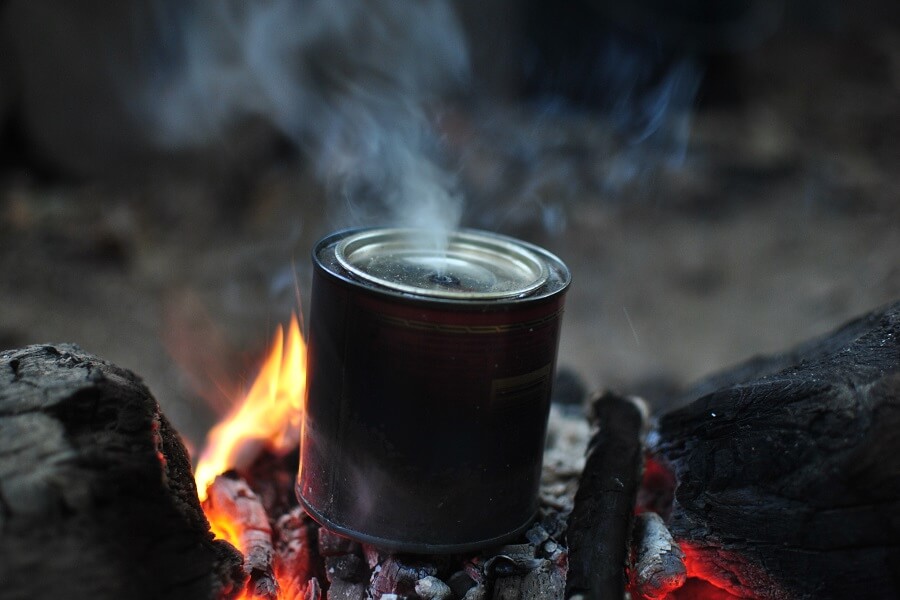There are many ways to light a fire and some of the basic deliver the most satisfaction. So have you ever tried to light a fire from a simple spark using a piece of flint and a steel? This should not be confused with a firesteel, one of those ferro or ferrocerium rods. When a firesteel is scraped properly it provides a shower of bright, white and extremely hot sparks to ignite a tinder bundle. Chipping away at a piece of flint with a steel by contrast creates paler sparks that are a cooler orange and far more sensitive to the tinder used.
Why do I need char cloth? To ignite a fire with a dull or pale spark, you will need a very dry tinder. With a very hot spark (e.g. firesteel), you may be able to light tinder that is damp, all be it not obviously so. With a piece of flint struck with a steel, the tinder will not ignite if the tinder is even slightly damp. This is why you need a very dry tinder called char cloth.

Char cloth is made from a cotton fabric, pretty much any 100% cotton fabric will do the job nicely. I make char cloth using, pieces of old denim jeans (no I don’t have any of that stretchy lycra stuff in my Levis), handkerchiefs that are passed their best and in this example (above) the remains of a Judo jacket (my sons).
Char cloth is made in a similar way to making charcoal – the material is heated to drive out all the moisture whilst not allowing it to combust! For char cloth, use a small tin can (e.g. a black treacle tin) that has a tight fitting lid – a small hole is pierced in the lid (more on this later). The cotton fabric is cut into strips, sufficient to fill the tin but still let enough air circulate around it – don’t over fill the tin.

The cotton material is placed loosely in the tin, I find that it’s best not to overfill. It’s ok if you do, it’s just that the charring process will take longer and some pieces may not be fully charred. The lid is then firmly pushed down to create a good seal and the tin containing the cotton placed on a heat source. Yes, that saying “which comes first the chicken or the egg” comes to mind! A fire is the obvious choice, but any heat source will do, a gas stove for instance. I wouldn’t recommend doing this in your kitchen on a cooker – not good at all.
So what is happening here? The heat is drying out the cotton – yes even though the fabric may feel dry to the touch, it really does have a moisture content that would fail you for your fire lighting. Thinking about the fire-triangle for a moment, the need for heat, fuel and oxygen. Placing the cotton in a tin with a tiny hole in the top means that the moisture driven off by the heat, escapes through the small hole. Because the small hole has steam flowing out, the oxygen flow is significantly reduced or hopefully eliminated, hence your cotton cloth does not combust in the tin!

Now don’t go away and forget about your char cloth in the making. As soon as it is completely dry, the flow of steam will cease, oxygen will enter the tin and your lovely char cloth will ignite leaving you with a tin of ash! Keep an eye on proceedings – a small tin like this will take somewhere between 20-30 minutes. As soon as the steam appears to have stopped, block the hole with a pointed stick and carefully take it of the heat and leave it to cool.
What happens if you don’t wait for it to cool? Yes, I have done this, in the interests of science of course. Using some fireproof gauntlets, I carefully removed the lid when still very hot, and not too surprisingly, the charred cloth burst into flames!

And what happens if you remove your tin from the heat to soon? Here is an example, the cloth is not fully charred, some of the cotton is brown rather than deep black. No, need to worry, just pop it all back in the tin and repeat the process – it’ll more often than not be fine. Of course, you could try the partially charred cloth to see what happens – it’s unlikely to work, but good to appreciate what happens if not fully charred.

This is what you are looking for, a jet-black, fully charred cloth. The fabric should be brittle and easily fall apart. A word of warning, you fab char cloth will now be soaking up the ambient moisture in the air – so I suggest you store it in an air-tight container ready for use!

Time to test the char cloth using a small piece of flint struck with a steel. With a super-dry piece of charred cloth, you should be able to drop a spark and ignite the cloth with comparative ease. Now of course this does rather depend on how much practice you have given to using the flint and steel.
If that has sparked your interest in fire lighting, then you may like to learn more fire lighting methods, on either my Art of Fire (both modern and primitive methods of fire lighting) or Bushcraft 101 (fire lighting along with other essential wilderness living skills) courses.